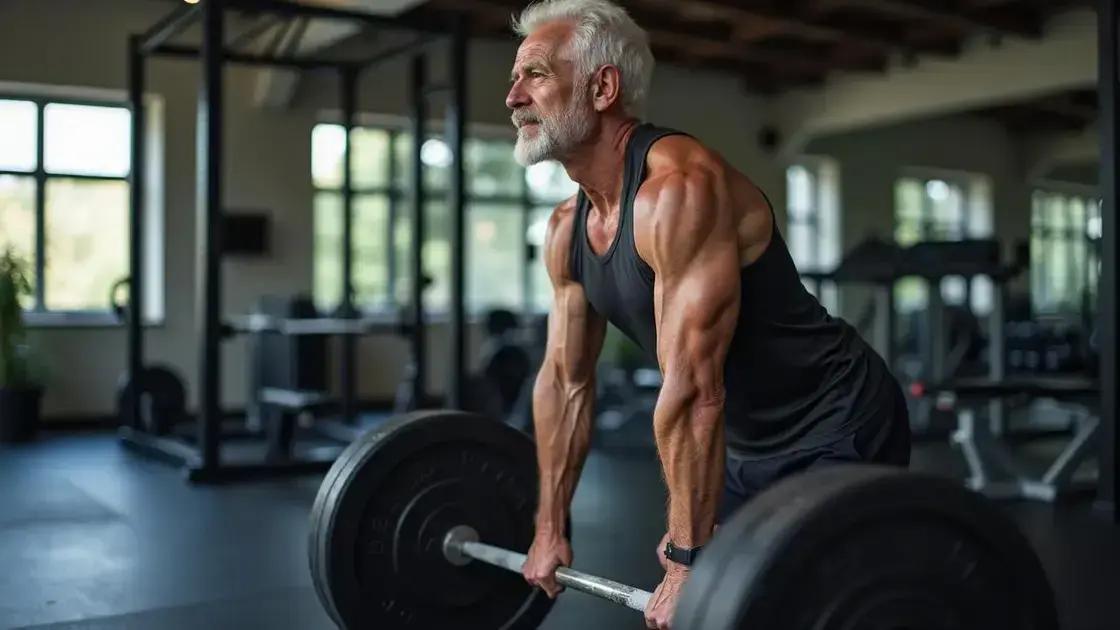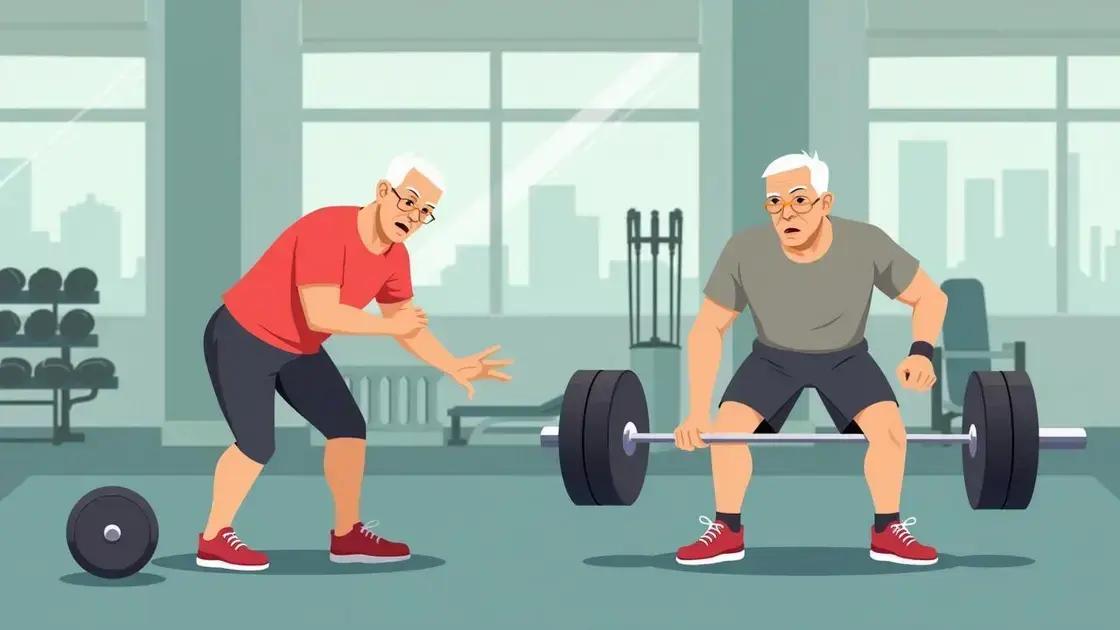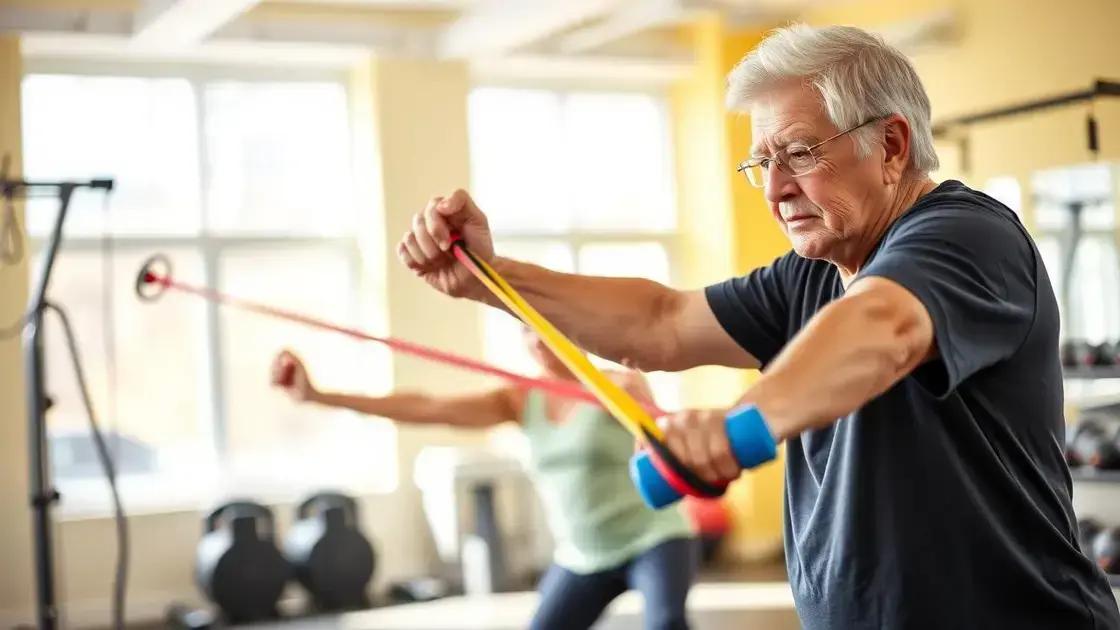Learning how to safely perform deadlifts after 50 is essential for maintaining strength and health; focus on proper form, start with lighter weights, avoid common mistakes, and incorporate strength training tips specific for older adults to enhance balance and muscle function.
As we age, staying fit and strong becomes increasingly important, particularly after 50. If you’re curious about how to safely perform deadlifts after 50, you’re in the right place! This powerful exercise can enhance your strength, improve posture, and boost overall health when done safely. In this article, we will dive deeper into understanding the benefits of deadlifts for older adults, key techniques to ensure safety, common mistakes to avoid, and additional strength training tips tailored for you.
Understanding Deadlifts and Their Benefits After 50

Understanding deadlifts and their benefits is vital for anyone, especially those over 50. Deadlifts are a type of weightlifting exercise that primarily target the muscles in the legs, back, and core. They involve lifting a barbell loaded with weights from the ground to hip level.
Benefits of Deadlifts After 50
As we age, maintaining muscle strength and bone density becomes crucial. Deadlifts offer numerous advantages for older adults:
- Improved Functional Strength: Deadlifts help build strength that translates to everyday activities, making simple tasks easier.
- Enhanced Posture: This exercise strengthens the muscles that support the spine, leading to better posture and reducing back pain.
- Increased Balance and Stability: As balance decreases with age, deadlifts train the core and lower body muscles, improving overall stability.
- Boosted Metabolism: Strength training, including deadlifts, can increase your metabolism, helping in weight management.
Safety Considerations
While deadlifts have many benefits, it’s important to focus on safety. Always consult with a healthcare provider before starting any new exercise routine. Begin with lighter weights and focus on proper form to minimize the risk of injury.
With the right approach, understanding deadlifts and their benefits can lead to a healthier, stronger life after 50.
Key Techniques for Safe Deadlifting Post-50

When it comes to safe deadlifting post-50, following key techniques is crucial to prevent injuries and maximize effectiveness. Here are some essential tips to keep in mind:
1. Warm Up Properly
Always start with a proper warm-up. This prepares your muscles and joints. Consider light cardio exercises like walking or cycling, followed by dynamic stretches that target your legs and back.
2. Focus on Form
Maintaining good form is essential. Your feet should be hip-width apart, with the bar positioned over the middle of your feet. Always keep your back straight, your chest up, and your core tight. Avoid rounding your back during the lift.
3. Use Lighter Weights
Begin with lighter weights to master the movement. Gradually increase the weight as your strength and confidence improve. This helps prevent strain on your muscles and joints.
4. Engage Your Core
Keep your core engaged throughout the lift. This helps stabilize your spine and supports your lower back. A strong core enhances your lifting power and reduces the risk of injury.
5. Practice Controlled Movements
Lift and lower the barbell in a slow, controlled manner. Avoid jerky movements that can lead to accidents or injuries. By taking your time, you will maintain better balance and posture.
6. Don’t Hesitate to Ask for Help
If you’re new to deadlifting or unsure about your technique, ask a trainer or experienced lifter for assistance. Learning from someone can greatly enhance your safety.
By applying these key techniques for safe deadlifting, you can enjoy the benefits of this exercise while minimizing the risk of injury.
Common Mistakes to Avoid When Deadlifting After 50

Knowing the common mistakes to avoid when deadlifting after 50 can significantly reduce your risk of injury. Here are some typical errors that many people make:
1. Lifting Too Heavy Too Soon
Many individuals feel pressure to lift heavier weights right away. This can lead to poor form and injuries. Start with lighter weights to master your technique.
2. Neglecting to Warm Up
Skipping warm-up exercises is a big mistake. A proper warm-up increases blood flow to your muscles, preparing them for the workout. Spend 5-10 minutes warming up before lifting.
3. Poor Form
Incorrect form is one of the most common mistakes. Always maintain a straight back, engaged core, and proper foot positioning while lifting. Bad form can result in serious injuries.
4. Forgetting to Breathe
Holding your breath during a lift can increase pressure in your body and lead to dizziness or fainting. Breathe out when lifting the weight and inhale when lowering it.
5. Lifting Too Quickly
This can cause loss of control and balance. Always lift and lower the weights slowly and steadily to maintain control and proper technique. Take your time with each repetition.
6. Ignoring Pain Signals
Listening to your body is essential. If you feel pain while deadlifting, stop immediately. Pushing through the pain can lead to serious injuries.
7. Lack of Recovery Time
Not giving your muscles enough time to recover can lead to fatigue and injury. Ensure you have rest days between intense lifting sessions.
By avoiding these common pitfalls, you can enjoy the benefits of deadlifting safely and effectively as you age.
Strength Training Tips for Older Adults

Strength training is essential for older adults to maintain muscle mass, improve balance, and enhance overall health. Here are some effective strength training tips tailored for those over 50:
1. Start Slowly
Always begin with light weights to assess your comfort and strength level. Starting slowly helps prevent injuries and allows you to focus on perfecting your form.
2. Focus on Compound Movements
Include exercises that work multiple muscle groups at once. Movements like squats, lunges, and deadlifts engage several muscles and are very effective.
3. Incorporate Resistance Bands
Resistance bands can be an excellent addition to your routine. They provide resistance without heavy weights and are easy to use at home or in the gym.
4. Prioritize Flexibility and Balance
Include stretching and balance exercises in your routine. Activities like yoga or tai chi can improve flexibility and help prevent falls.
5. Schedule Regular Workouts
Create a consistent routine and aim for strength training at least 2-3 times per week. This consistency helps build strength over time.
6. Listen to Your Body
Pay attention to how your body feels during and after workouts. If you experience pain or discomfort, stop and rest. Always prioritize your safety.
7. Stay Hydrated
Drinking enough water is essential, especially during workouts. Proper hydration supports muscle function and overall health.
8. Seek Professional Guidance
If you are unsure about starting a strength training program, consider working with a certified trainer. They can provide personalized guidance and ensure that you use correct form.
By following these tips for strength training, older adults can effectively increase their strength and improve their quality of life through safe and sustainable practices.
Embracing Strength Training Safely After 50
Engaging in strength training after the age of 50 can significantly enhance your physical health and overall well-being. Understanding the benefits of exercises like deadlifts, avoiding common mistakes, and applying key techniques can make a remarkable difference in your fitness journey.
It’s essential to remember that starting slowly, focusing on proper form, and incorporating flexibility and balance exercises are crucial for a safe and effective training regimen. By following the tips laid out in this guide, you can build strength, improve posture, and boost your confidence as you age.
Ultimately, strength training not only helps you maintain independence but also fosters a happier and healthier lifestyle. So, take charge of your fitness and start safely incorporating deadlifts and other strength training exercises into your routine today!
FAQ – Frequently Asked Questions About Deadlifting After 50
Is deadlifting safe for people over 50?
Yes, deadlifting can be safe and beneficial for individuals over 50 when done with proper form, lighter weights, and warm-up exercises.
What are the main benefits of deadlifting after 50?
Deadlifting helps improve muscle strength, enhance posture, increase balance, and boost overall health, which is crucial as we age.
What are some common mistakes to avoid when deadlifting?
Common mistakes include lifting too heavy too soon, neglecting to warm up, using poor form, and ignoring pain signals.
How can I improve my deadlifting technique?
Focusing on maintaining a straight back, engaging your core, and practicing controlled movements can significantly enhance your deadlifting technique.
What strength training tips should older adults follow?
Older adults should start slowly, focus on compound movements, incorporate resistance bands, and schedule regular workouts to maintain strength safely.
How often should I train with weights?
Aim for strength training sessions at least 2-3 times per week, with adequate rest days to allow for recovery.












